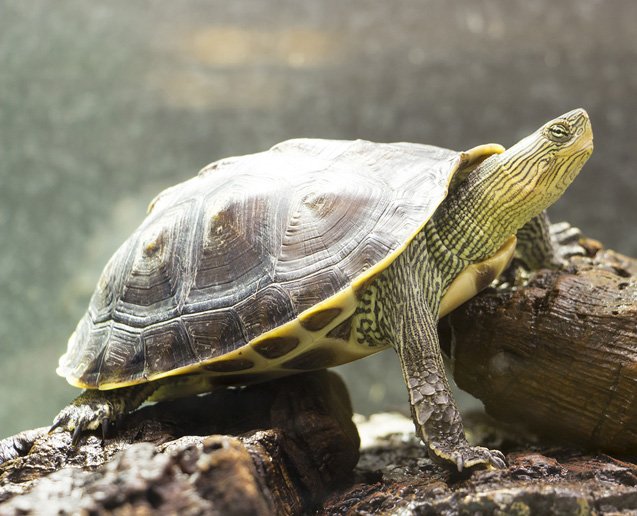Chinese Stripe Necked Turtle


About Chinese Stripe Necked Turtle
Also known as the Golden Thread Turtle, the Chinese Stripe Necked Turtle is one of the most beautiful turtles that are kept as pets. However, in the wild, these turtles are endangered, and part of the reason why is because they are taken from their natural homes to be put into the pet trade. Therefore, if you are hoping to introduce a Chinese Stripe Necked Turtle into your family, be absolutely sure that the animal was captive bred.
The Chinese Stripe Necked Turtle is one of the most beautiful turtles that are kept as pets.
The Chinese Stripe Necked Turtle is mainly found in areas that are in eastern China, and their habitat extends to eastern Laos and central Vietnam. You can also find these turtles on the islands of Taiwan and Hainan.
This turtle breed can inhabit a wide range of climates, including tropical, subtropical, and temperate. It also lives in just about all freshwater habitats, including rivers, drainage ditches, small ponds, and large lakes. These turtles have strong muscles and webbed feet that allow them to be powerful swimmers, even when they are in bodies of water that have a moderate current.
When looking at the Chinese Stripe Necked Turtle, you will see that the head is narrow and the snout is slightly pointed. You will notice that this turtle also features scales covering the forelimbs, and every limb is webbed.
You can differentiate between adult males and adult females because the females will be bigger, and the males will also feature a plastron that is slightly concave.
If you wish to keep a community tank, the Chinese Stripe Necked Turtle is a good choice.
The Chinese Stripe Necked Turtle features fine black and yellow lines on the neck, and it is these lines that give the breed its name.
The carapace will be anywhere from black to reddish-brown in color, and the horny scutes are also outlined in yellow. The plastron will be yellow and there will be a large black or brown blotch on every scute.
This turtle’s limbs will be olive and covered in the same fine yellow lines that are found on the neck. The chin and jaw feature a cream hue.
You can use a glass tank, plastic storage bin, sweaterbox, or stock tank for your Chinese Stripe Necked Turtle’s enclosure. If you have a female who is 10”, she will need at least 100 gallons of space, and if you have a 5” male with two 10” females, they will need a minimum of 150 gallons.
When choosing tank furnishings, make sure that they are securely set in place and that they are appropriate for the size of your pet. For example, if you have a small turtle, you can provide him with a smaller basking area, but if he grows larger, you will need to upgrade the basking site so that your pet can come out of the water and dry completely. And if there are any materials in the tank, make sure that your turtle can’t get trapped under them while underwater.
Use a water heater to maintain the water temperature anywhere from 75-80°F, and keep the air temperature in the tank anywhere from 80-85°F. The basking area should be set to anywhere from 85-90°F, and there should be a UVB light overhead.
Keeping the water as clean as possible is important to the health of this turtle, so invest in a high quality water filter for the enclosure.
Limit handling your Chinese Stripe Necked Turtle unless it is absolutely necessary.
Chinese Stripe Necked Turtles are omnivorous, so they will eat both animals and plants. Mature females, however, will be more herbivorous, while young females and males are predominantly carnivorous.
These turtles are easy to feed, as they will rarely refuse food that is offered to them. You can give your pet a commercial pellet diet for turtles, as well as water hyacinth, water lettuce, duckweed, and romaine lettuce, which you can leave floating in the water.
If you wish to keep a community tank, the Chinese Stripe Necked Turtle is a good choice. These turtles are social, much like sliders and cooters. Just keep in mind that, to prevent injuries, the biggest turtle in the tank should not be over twice the size of the smallest turtle in the enclosure.
As is the case with many turtle breeds, it is best to limit handling your Chinese Stripe Necked Turtle unless it is absolutely necessary. And remember to purchase your turtle from a reputable breeder who can guarantee that your pet was captive bred, as you do not want to purchase one that was taken out of the wild, where this species is endangered.
Photo credit: KovalenkovPetr/Bigstock; Life on White/Bigstock; Marina Jay/Bigstock

Lisa Selvaggio is a freelance writer and editor, and our resident cats-pert, with certifications in pet nutrition and pet first aid. She enjoys producing content that helps people understand animals better so they can give their pets a safe and happy home.
More by Lisa Selvaggio
























